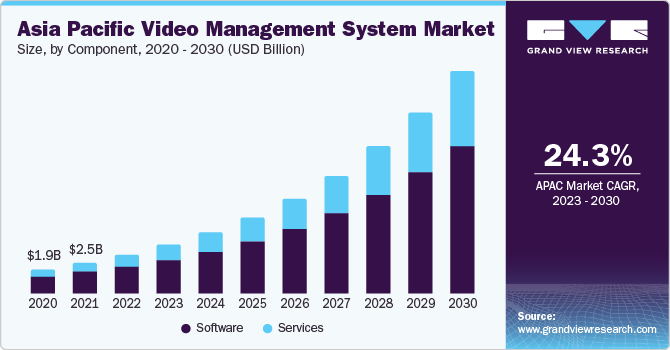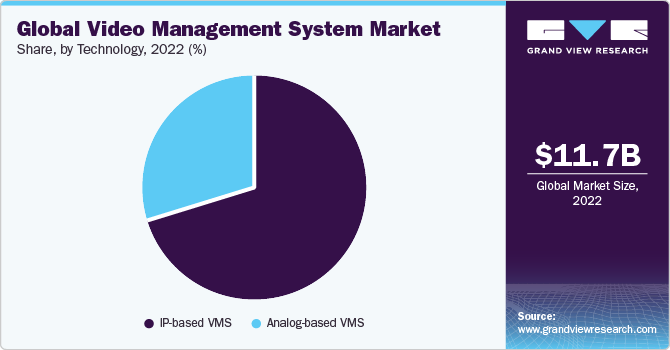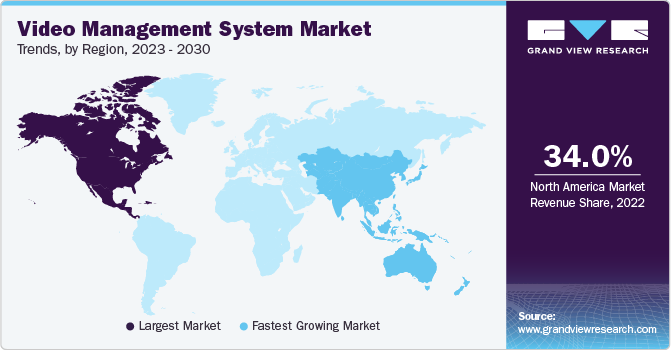- Home
- »
- Next Generation Technologies
- »
-
Video Management System Market Size, Share Report, 2030GVR Report cover
![Video Management System Market Size, Share & Trends Report]()
Video Management System Market (2023 - 2030) Size, Share & Trends Analysis Report By Component (Solution, Services), By Technology, By Deployment, By Enterprise Size, By Application, By End-user, By Region, And Segment Forecasts
- Report ID: GVR-4-68040-134-1
- Number of Report Pages: 100
- Format: PDF
- Historical Range: 2017 - 2021
- Forecast Period: 2023 - 2030
- Industry: Technology
- Report Summary
- Table of Contents
- Segmentation
- Methodology
- Download FREE Sample
-
Download Sample Report
Video Management System Market Trends
The global video management system market size was estimated at USD 11.70 billion in 2022 and is projected to grow at a compound annual growth rate (CAGR) of 20.3% from 2023 to 2030. Rapid deployment of video management systems (VMS) for traffic management and surveillance is a significant factor driving the growth of the market. These solutions are crucial in improving traffic safety and preventing road accidents by monitoring numerous closed-circuit television (CCTV) video feeds from various locations in a central network operations center. In many countries, there is a growing trend towards adopting VMS to reduce road traffic injuries and accidents.

According to the World Bank, an international financial institution, approximately 1.3 million people die yearly due to road traffic accidents. Video management systems are instrumental in this context as they encode and manage multiple CCTV and surveillance video streams from live traffic cameras placed on roads. These systems promptly detect incidents and continuously gather real-time traffic data, reducing traffic congestion and enhancing overall highway safety. These factors are significant drivers of the market's revenue growth.
Many industry players are actively designing and developing artificial intelligence (AI) and machine learning (ML) algorithms to enhance automation within video security significantly. This technological evolution benefits both business-to-consumer (B2C) and business-to-business (B2B) users by enabling the detection and flagging of unusual movements while dramatically reducing the time required for reviewing recorded video footage from hours to mere minutes. In addition, there is a growing trend of increased government interest in investing in cloud-based video surveillance solutions across various regions. This heightened government involvement is anticipated to be a major driver for revenue growth in the market over the forecast period.
Component Insights
Based on component, the solution segment led the market in 2022 with the largest revenue share of over 68.0%. Organizations often favor video management solutionsthat seamlessly integrate with other security systems, IoT devices, and analytics platforms for their ability to provide a unified security ecosystem. Video management solutions play a pivotal role across various sectors, offering various applications. For instance, in the retail landscape, it leverages analytical data from in-store cameras to make informed decisions about product placement, optimizing the shopping experience. In addition, large enterprises and academic institutions commonly utilize video management solutions and software for many objectives, including corporate training, executive communication, live event streaming, and knowledge management.
The services segment is estimated to grow significantly over the forecast period. The services segment is divided into professional and managed services. Professional services encompass a range of offerings, such as education, training, certification, consulting, planning, implementation, management, and support/maintenance. These services are essential as many end-users lack the technical expertise to effectively store and handle video data. They seek professional service providers to address this challenge. On the other hand, managed services are provided by third-party vendors who assist enterprises in managing their operational complexities related to VMS. These services help organizations overcome operational hurdles.
Technology Insights
Based on technology, the IP-based VMS segment led the market in 2022 with the largest revenue share of over 69.0%. IP-based video management systems (VMS) enable numerous organizations to establish video systems by leveraging standard computer hardware and cost-effective video formats. The continuous development in video processing architecture, like dynamic range high-efficiency video coding (HEVC) transcoding and real-time communication capabilities, drives substantial demand for IP-based VMS. Real-time communication capabilities further bolster the demand for IP-based VMS. They enable seamless and instantaneous data transmission, facilitating quick decision-making and response in various applications, from security and surveillance to industrial monitoring.

The analog-based video management systems (VMS) segment is estimated to grow significantly over the forecast period. Analog-based VMS can generate dynamic range high-efficiency video coding (HEVC) content tailored for enterprise users. In addition, these systems simplify and expedite prototyping, deployment, and operation tasks. One key benefit of analog-based VMS is their ability to support various cameras, including the latest IP and older analog cameras. This versatility allows organizations to leverage their existing camera infrastructure while integrating newer, more advanced IP cameras when needed. This adaptability is valuable for businesses transitioning from analog to digital systems.
Deployment Insights
In terms of deployment, the on-premises segment held the largest revenue share of over 58.0% in 2022. Due to their advantages of flexibility, cost-effectiveness, and scalability, on-premise solutions are gaining prominence across various industry verticals, including traffic management building and infrastructure management. Many organizations actively embrace VMS to enhance their streaming experiences by deploying these systems within their internal IT infrastructure, often leveraging real-time messaging protocol (RTMP) encoders. By hosting these systems within their IT infrastructure, organizations can tailor the software to their specific needs and maintain higher security and data control.
The cloud segment is anticipated to register the fastest CAGR of 26.9% over the forecast period. Many organizations embrace cloud-based video management systems to provide proactive and tailored experiences, incentivizing distributors and vendors to enhance their VMS technology and licensing agreements. Cloud-based deployment models deliver scalable and cost-effective solutions for encoding various video formats, depending on the codecs used. Cloud-based video management systems enable organizations to deliver more personalized and responsive experiences to their users or customers. These systems offer the flexibility to scale resources up or down based on demand, making them a cost-efficient choice.
Enterprise Size Insights
In terms of enterprise size, the large enterprise segment held the largest revenue share of over 68.0% in 2022. Large enterprises typically have more extensive and complex video surveillance needs and often require advanced features and functionalities in their VMS solutions, such as analytics, integration with other security systems, and cloud-based storage. Furthermore, security is a top priority for large enterprises. VMS systems are known for their robust security features, including encryption and authentication protocols, which are crucial for protecting sensitive video data. These factors are significant drivers of the segment's revenue growth.
The small & medium size enterprise segment is anticipated to register the fastest CAGR of 22.7% over the forecast period. Advancements in technology have advanced video intelligence to new peaks, significantly enhancing accuracy and performance. This progress is largely attributed to the development of artificial intelligence (AI) and deep learning algorithms. AI substantially impacts various industries and markets, including small and medium-sized enterprises (SMEs). SMEs face the task of sifting through countless recorded videos to uncover evidence of specific events. With AI-driven solutions, they can experience real-time alerts with remarkable precision, reducing unnecessary distractions.
Application Insights
Based on application, the security & surveillance segment held the largest revenue share of over 27.0% in 2022. The primary driver for adopting VMS in security and surveillance is the increasing need for effective security measures. Organizations and governments constantly seek ways to enhance security and protect their assets, leading to a growing demand for advanced surveillance solutions. Growing security concerns, both in public and private sectors, have led to higher demand for video surveillance solutions. These concerns encompass protecting physical assets, monitoring public spaces, enhancing safety, and preventing unauthorized access. Furthermore, the video surveillance industry has been continuously innovating with advancements such as high-definition (HD) and ultra-high-definition (UHD) cameras, smart analytics, and artificial intelligence (AI) integration. These technologies improve the effectiveness and efficiency of security systems.
The data integration segment is predicted to foresee significant growth in the forecast period. Data integration is critical to adopting VMS in modern security and surveillance environments. Integrating data from VMS systems with other sources and applications enhances the functionality and effectiveness of surveillance operations. Data integration allows VMS systems to incorporate data from sensors, access control systems, and IoT devices. This comprehensive view of data provides security personnel with improved situational awareness, enabling them to respond more effectively to security incidents.
End-user Insights
In terms of end-users, the government segment held the largest revenue share of over 28.0% in 2022. Governments have a crucial responsibility for ensuring public safety and security. VMS play a vital role in surveillance, monitoring critical infrastructure, and managing security in public spaces, contributing to a significant market share. Furthermore, police and law enforcement agencies use VMS for crime prevention, investigation, and public safety. The demand for sophisticated systems to enhance these capabilities drives significant market share in the government segment.
The transportation and logistics segment is anticipated to register the fastest CAGR of 24.4% over the forecast period. VMS are essential for traffic monitoring, management, and ensuring road safety. As urbanization and population growth lead to increased traffic, there is a growing demand for intelligent video solutions for traffic optimization and safety. The transportation industry, including airports, seaports, and railways, increasingly needs robust security measures. VMS play a crucial role in monitoring and securing transportation infrastructure.
Regional Insights
In terms of region, North America dominated the market in 2022 with a revenue share of over 34.0%. The rapid adoption of VMS for traffic management and highway safety is a key driver behind the revenue growth of the market in this region. These systems are vital in monitoring traffic conditions and enhancing highway safety. They leverage video analytics to monitor vehicle speed, and traffic cameras provide real-time alarm monitoring and facilitate clear communication between the system and security personnel. Furthermore, there is a substantial demand for cost-effective cloud-based video surveillance and VMS in sectors like healthcare and infrastructure. This demand is expected to remain high throughout the forecast period.

Asia Pacific is anticipated to register the fastest CAGR of 24.3% over the forecast period. The adoption of VMS in smart city projects and urban development played a key role in driving market growth in the region. VMS applications are significantly used in smart cities such as Beijing, Singapore, Tokyo, Shenzhen, Thailand, and Melbourne. The VMS is an important component of a smart city, and it helps governments as well as municipalities to make cities safer and more effective and enhance living quality.
Key Companies & Market Share Insights
Prominent firms have used product launches and developments, followed by expansions, mergers and acquisitions, contracts, agreements, partnerships, and collaborations, as their primary business strategy to increase their market share. The companies have used various techniques to enhance market penetration and boost their position in the competitive industry. For instance, in May 2023, Icomera AB, a company known for its integrated connectivity solutions tailored for trains, trams, buses, and coaches, has recently introduced a cutting-edge real-time video surveillance management system. This system is a key component of the Icomera Network Insights and Control (ICONIC) software suite, and it offers a robust video management solution that seamlessly integrates into a secure, distributed, and web-based framework. Some prominent players in the global video management system market include:
-
Robert Bosch GmbH
-
Honeywell International Inc.
-
Schneider Electric SE
-
Axis Communications AB
-
Johnson Controls
-
Hangzhou Hikvision Digital Technology Co., Ltd.
-
NetApp, Inc.
-
Zhejiang Dahua Technology Co., Ltd.
-
Verint Systems Inc.
-
LTIMindtree Limited
Video Management System Market Report Scope
Report Attribute
Details
Market size value in 2023
USD 14.20 billion
Revenue forecast in 2030
USD 51.68 billion
Growth rate
CAGR of 20.3% from 2023 to 2030
Base year for estimation
2022
Historical data
2017 - 2021
Forecast period
2023 - 2030
Quantitative units
Revenue in USD million/billion and CAGR from 2023 to 2030
Report coverage
Revenue forecast, company ranking, competitive landscape, growth factors, and trends
Segments covered
Component, technology, deployment, enterprise size, application, end-user, region
Regional scope
North America; Europe; Asia Pacific; Latin America; MEA
Country scope
U.S.; Canada; UK; Germany; France; China; Japan; India; South Korea; Australia; Brazil; Mexico; Kingdom of Saudi Arabia (KSA); UAE; South Africa
Key companies profiled
Robert Bosch GmbH; Honeywell International Inc.; Schneider Electric SE; Axis Communications AB; Johnson Controls; Hangzhou Hikvision Digital Technology Co., Ltd.; NetApp, Inc.; Zhejiang Dahua Technology Co., Ltd.; Verint Systems Inc.; LTIMindtree Limited
Customization scope
Free report customization (equivalent up to 8 analysts working days) with purchase. Addition or alteration to country, regional & segment scope.
Pricing and purchase options
Avail customized purchase options to meet your exact research needs. Explore purchase options
Global Video Management System Market Report Segmentation
This report forecasts revenue growth at global, regional, and country levels and provides an analysis of the latest industry trends in each of the sub-segments from 2017 to 2030. For this study, Grand View Research has segmented the global video management system market report based on component, technology, deployment, enterprise size, application, end-user, and region:
-
Component Outlook (Revenue, USD Billion, 2017 - 2030)
-
Software
-
Services
-
Professional Services
-
Managed Services
-
-
-
Technology Outlook (Revenue, USD Billion, 2017 - 2030)
-
Analog-based VMS
-
IP-based VMS
-
-
Deployment Outlook (Revenue, USD Billion, 2017 - 2030)
-
Cloud
-
On-premises
-
-
Enterprise Size Outlook (Revenue, USD Billion, 2017 - 2030)
-
Small & Medium Size Enterprise
-
Large Enterprise
-
-
Application Outlook (Revenue, USD Billion, 2017 - 2030)
-
Security & Surveillance
-
Intelligent Streaming
-
Advanced Video Management
-
Data Integration
-
Navigation Management
-
Storage Management
-
Others
-
-
End-user Outlook (Revenue, USD Billion, 2017 - 2030)
-
BFSI
-
Government
-
IT & Telecommunication
-
Healthcare and Life Sciences
-
Manufacturing
-
Transportation and Logistics
-
Others
-
-
Regional Outlook (Revenue, USD Billion, 2017 - 2030)
-
North America
-
U.S.
-
Canada
-
-
Europe
-
Germany
-
UK
-
France
-
-
Asia Pacific
-
China
-
Japan
-
India
-
South Korea
-
Australia
-
-
Latin America
-
Brazil
-
Mexico
-
-
Middle East and Africa (MEA)
-
Kingdom of Saudi Arabia
-
UAE
-
South Africa
-
-
Frequently Asked Questions About This Report
b. The global video management system market size was estimated at USD 11.70 billion in 2022 and is expected to reach USD 14.20 billion in 2023.
b. The global video management system market is expected to grow at a compound annual growth rate of 20.3% from 2023 to 2030 to reach USD 51.68 billion by 2030.
b. North America dominated the video management system market with a share of 34.7% in 2022. The rapid adoption of video management systems for traffic management and highway safety is a key driver behind the revenue growth of the market in this region.
b. Some key players operating in the video management system market include Robert Bosch GmbH, Honeywell International Inc., Schneider Electric SE, Axis Communications AB, Johnson Controls, Hangzhou Hikvision Digital Technology Co., Ltd., NetApp, Inc., Zhejiang Dahua Technology Co., Ltd., Verint Systems Inc., LTIMindtree Limited
b. Key factors that are driving the video management system market growth include increasing security concerns, and smart city initiatives.
Share this report with your colleague or friend.
Need a Tailored Report?
Customize this report to your needs — add regions, segments, or data points, with 20% free customization.

ISO 9001:2015 & 27001:2022 Certified
We are GDPR and CCPA compliant! Your transaction & personal information is safe and secure. For more details, please read our privacy policy.
Trusted market insights - try a free sample
See how our reports are structured and why industry leaders rely on Grand View Research. Get a free sample or ask us to tailor this report to your needs.










